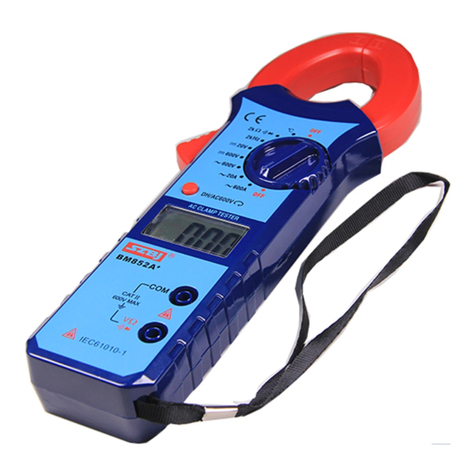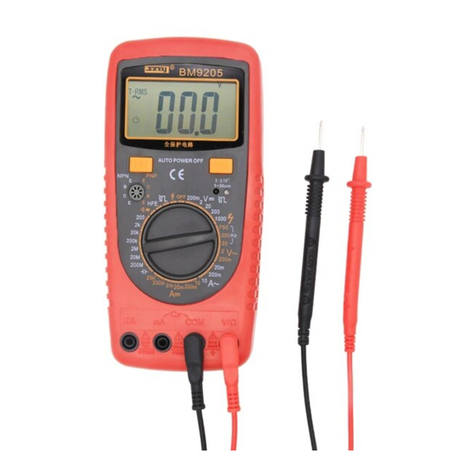
2
(6)INRUSH:measuring Inrush voltage, current key,in AC measuring function press
the key,it will measure the Inrush value, and show the "INR" symbol in the
LCD, INRUSH function can measure current or voltage with the minimum period up
to valid values80mS,in the inrush mode, instrument automatically enter the manual
range function, if the measurement range is unknowed , press RANGE key to the
maximum range, first press the INRUSH button again inrush measurement will be
resumed, and the "INR" symbol disappear.
(7)“DH” button: The user may hold the present reading and keep it on the display
by pressing the “DH” button. Press the button again to concel the data-hold function
(8)LCD display
(9)“V”jack: This is positive input terminal for voltage,resistance
frequency,temperature,capacity and diode.
(10) “COM”jack:This is negative(ground)input terminal
(11) Barrier
4.2 Measurement of AC/DC voltage
Turn the Rotary switch to “V”. Then plug black lead in “COM” socket, and plug
red lead in “V/” socket. connect the test lead with the two ends of the circuit and
then directly read the reading on the LCD display
NOTE: 1. The inrush measuring funciton can only be change range manually, before
the test,if the voltage is unknown, manually set the measuring range to 700V and then
press the PH key to enter the INRUSH measuring function.
2. Don't measure the peak voltage more than 1000V, otherwise it might damage the
instrument ,if the screen only displays OL, it means that the tested voltage is higher
than DC1000V or AC700V.
3. Presse the SRLECT key in the ACV function to enter the voltage frequency
measurement mode, it can measure the the frequency range from 10Hz to 100KHz
with voltage higher than AC 30V~700V.
4.3 AC current measurement
Turn rotary switch to“~A” range. Press the trigger, opens the mouth of the
clamp, and hold wire ( put the wire in the clamp center ), read the reading directly
Note:1.INRUSH measuring can only be manually setting range. when the
current value being measuring is unknow, turn the rotary switch to 1000A and
press INRUSH key to entry INRUSH measuring funciton.
2. When measuring current ,the clamp might hold only one wire,it is null to
catch one more another wire
4.4 Measurement of resistance,continuity and forward Voltage drop of diode
Warning! When measurement of resistance or continuity, make sure that no
voltage is with the circuit and components.
(1)Turn the Rotary switch to the range of Ω/ / . At this time, the meter is
reserved at resistance range.
(2)Plug red lead in “V/Ω” socket, and plug black lead in “COM” socket
(3)Connect the leads with the two ends of the circuit or component, and then read
the value of resistance.
(4)Press SELECT key to change the range of . When the resistance measured
is less than about 90±20, the buzzer sounds. This is continuity testing.
(5)When the test lead is under open-circuit or input-overload status, the display will
display “OL”.
(6)When measuring diode,press the SELECT key to the function of .
(7)Connect the test lead with the two ends of the diode, and then read the value of
forward voltage drop value.
(8)When the test lead is under reverse connection or open-circuit status, the display
will display “OL”.
Note:a、When the resistance measured is above 1MΩ, it needs several seconds for
the reading to be stable, it is normal when measuring high resistance.
b、When measuring high resistance, insert the resistance pin directly into the V Ω and
COM jack, so as to avoid interference
c、When measuring resistance in a circuit make sure the power to the circuit is turned
off and all capcitors are discharged,
4.5 Measurement of capacitance
Warning! When measurement of capacity, the measured capacitor should be
completely discharged.
(1)Turn the Rotary switch to “CAP” function. Plug red lead in “V/Ω” socket, and
plug black lead in “COM” socket.
Warning:The range for capacitor can’t be set manually. When the capacity value
is large, the time for measurement may be a little longer.
a. Do not take an external voltage or charged capacitor (especially a large
capacitor) connected to the test terminal
b. When a large capacitor is serious leakage or breakdown, the measurement value
may be instability
4.6 Measurement of frequency / DUTY Ratio
(1)Turn the Rotary switch to “Hz” function.if you want to measure DUTY
Ratio,Press SELECT key to switch
(2)Plug red test lead in “V/Ω” terminal and plug black lead in “COM” terminal.
(3)Connect the leads with measured circuit and then read the reading.
(4)when the voltage exceeding 30V, please enter the Voltage frequency
measurement mode by pressing the SELECT key in the “ACV” measurement
function.
4.7 Measurement of temperature
Turn the Rotary switch to the function of temperature, then plug the cold end
(plug end) of temperature sensor to the V/Ωand COM socket(black end for COM
socket and red end for V/Ω socket). Place the working end (temperature end) of the
sensor on or in the measured object. Then read the temperature value (in ) on the ℃
display. If you need to measure that “OF”, presses the SELECT key to switch.
Caution: When the cold terminal of the sensor isn’t inserted into the meter, the
meter might display approximate environmental temperature. K WRNM- 010 bare
contact thermojunction has a limiting temperature of 250℃ (300℃ for short time).
4.8 NON CONTACT VOLTAGE TESTING
Turn the Rotary switch to the “ ” function, then the LCD display NCV and ~
symble, plug red test lead in the “V/Ω” terminal and black lead without being
used,place the red test lead near the electric line, switch,or socket,the phase metal
terminal need not to be connected,when the detected voltage is above AC RMS
110V,a reverse C will be displayed on the LCD,the higer the testing voltage is ,the
more reverse C will be display,with buzzer alarm sounds more intensive.
When the meter has no response to the voltage,you can contect the red test lead to the
metal of the terminal.
Caution:
1.even if there is no indication, voltage may still exist. Do not judge the wire whether
threre is voltage absolutely throught the non contact voltage testing,the testing may be
effected by many factors such as the socket design,the insulation thickness and types
etc.
2.Interference source of external environment,such as flash,motor etc,may false
triggle the non contect voltage testing.
Ⅴ. Maintenance of meter
Warning! Switch off the power, remove the test lead and any of input
signals to prevent electric shock before opening the cover of meter or the cover of
battery.
5.1 When the meter displays the symbol of “ ”, the battery should be changed.
Open the battery cover, and then change the used battery with new battery to ensure
the normal operation of the meter.
5.2 Keep the meter and the pens clean, dry and non-destructive. Clean cloth or
detergent may be used for cleaning the cover of the meter. No grinding agent or
organic solvent can be used for the same cleaning purpose.
5.3 The meter should be protected against damage, vibration and impact. It
shouldn’t be placed where high temperature or intense magnetic field exists.
5.4 Calibrating of the meter is done on a yearly basis.
Ⅵ. Accessories
6.1 Test lead: 1 set
6.2 Users manual: 1 piece
6.3 Temperature sensors: 1 set
6.4 Cloth bag: 1piece
























